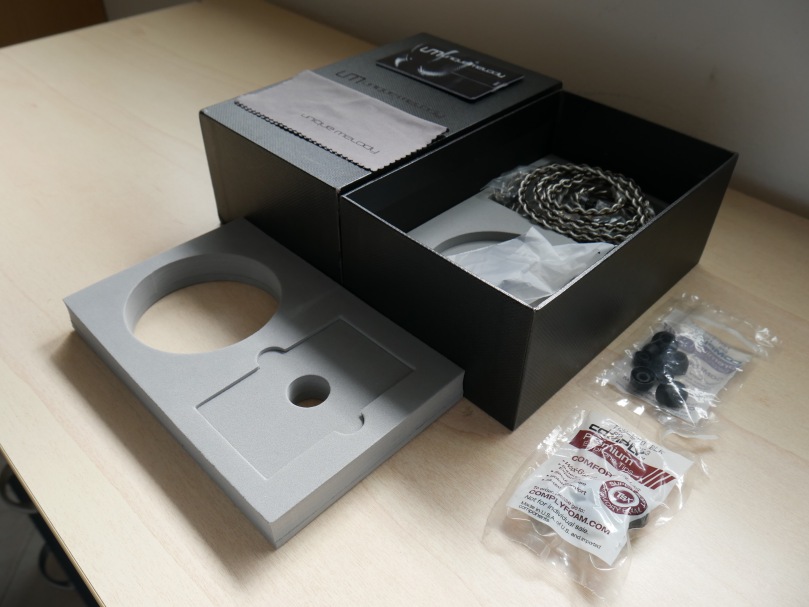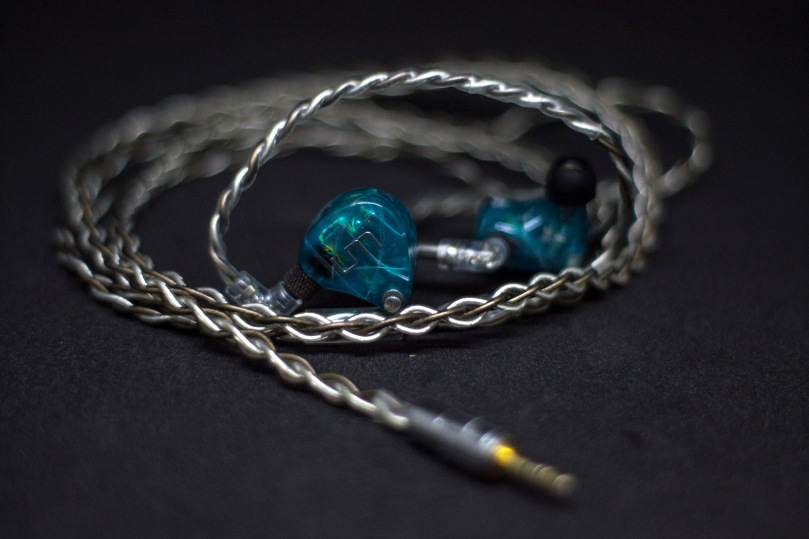Intro
Once I said that you don’t generally love In-Ear Headphones until you heard a really good one. I meant that you can generally dislike this kind of products, but a really good sound could make you forget the eventual issues regarding, for example, the ear fit. Well, these IEMs by Unique Melody are that good, under some points of view. And, luckily for me, they also don’t have any enormous fit issue.
I want to start with some useful information. First, these are 2700$ monitors; that means two things: they aren’t, obviously, a popular product, and they are meant for professional users. It’s a role – the pro – that I don’t exactly embody, because even though I’ve been a musician and I’m constantly “around” music, I don’t actually perform live nor professionally record. But I do something concerning records on my own, and I’ve tried the V3s – as far as possible – with some more stressful works than merely reproducing music.

Unboxing
Usually, when you climb the price range hill, there’s a point where the quality stops going up with the price. That is a difficult step to predict nowadays, but I push a button: I’m not sure that over 1000/1500$ what you get is what you really pay for. But here comes the real deal: what makes the Mason premium isn’t just the product, but the overall experience you get. Starting from the elegant black box, in which they put a lot of useful accessories.
First, I got impressed by the carrying metal box (actually made of titanium) that’s inside: it’s way heavier than expected. That prevents any possible damage to the earphones, but it’s not very handy.
There are a lot of ear tips, which comes from one of the best manufacturers out there (COMPLY); a pair of them is a foam one, really comfortable and sealing by my ears.
They actually include three cables to adapt the M3s to a SE (3.5mm) or balanced (2.5mm/4.4mm) output on your source. I believe these are very expensive cables, and they make a great piece of the price. Besides the price, they are amazing hand-made braided cables (actually, they braid other cables together, cable-ception! – editor’s note). They use a 4-pin proprietary standard, secured by a screw, sort of, to help it not to detach. Replacing it is pretty easy.
Inside the box there’s also minor UM branded stuff: the cure is impressive, and as we’ll see this is something concerning every area of these IEMs. You also find a funny USB stick with some pictures and info about the V3 inside.

Design and Fit
As I said before, I didn’t have fit issues with the Mason. But there’s a matter regarding my ears that’s worth a mention: I can’t wear them for a long time. Like most of the monitors out there, they are just too big for me not to hurt, and this might be an issue if I were a live performer. I’m not, and I have to say they really stay in place like they’re meant to. Obviously, a custom version would fit better and avoid the pain – which I have, but you may not.
The design is classic for an IEM, but gets some interesting and unique features. First, their translucent blue finish let you see through the shell, revealing the insane number of balanced armatures crammed inside (13 or 16 depending on the version). The shell itself is made of acrylic and gives a solid and good-looking impression.
Another thing that’s worth mentioning is how easily you can change the ear tips: it may sound stupid, but some IEMs that I’ve tried in the past were so hardly attached to the monitor’s body to make it difficult to exchange one another.

Sound
I don’t want to result too critical in this review, but this is the most important part of it and I want to be honest: I didn’t love these IEMs, even though I liked them very much in many ways.
Here are my reasons.
There are a lot of positive things about them. Their precision is insane, and the sound resolution really amazed me. But here’s the problem for me: the sound changes too much depending on the source. I listened to the same track in FLAC on my DAP (FiiO M7) and in MP3 on my iPhone and again in FLAC with my Scarlett 2i2 attached to my 2012 MacBook Pro and with the Audirect Beam attached to my Xiaomi Mi Mix 2. I’ll list the experience I’ve had with all of them:
- FiiO M7: at first approach, I got caught by the incredible imaging created by the Mason. The very first impression was of a great monitor for the voices and the drums, while not for the bass, that I felt undertone. Also, the treble was clear and pleasant. By listening carefully, I noticed that while the voices tend to emerge, some harmonics get cut. At first, I believed this was a sort of tuning to make the voice standing out, but then I tried to listen to that track on my iPhone;
- iPhone SE: believe me or not, the MP3 of that track sounded better here than the FLAC there. You may think it’s a question of DAC – obviously – but don’t you think that a dedicated instrument like a Hi-Res certified DAP should sound better than an average phone with lossy files? Well, here I started to search for the problem. The iPhone sourced (can I say that?) MP3 had many more harmonics in the treble area of the voice than the FLAC on my DAP, and this is strange because it’s not hard to know that the situation should be the opposite. I obviously didn’t use MP3s to test the Mason, I just knew that song very well so I did sort of a blind trial.
- Scarlett 2i2: this entry level audio interface is well-known and, given his nature, you can imagine that the sound is pretty accurate. It is: I understood the frequency response of the V3 better by listening to them through this source. They appear to have a little V-shaped graph, with a little cut-out in the lower mids. They actually provide a sound that I’d describe as funny, certainly not a reference one but they are not meant to. There is a great detail, impressive every time I listen to them. The soundstage is wide: mainly expanded on the lower side, also very good on the treble area. I hear a little bit of a hiss with higher female voices, but it may be a source’s fault.
- Audirect Beam x Mi MIX 2: good combo, because of the pretty neutral sound provided by the Beam. You hear well the V-shaped signature with albums like “My iron lung” by Radiohead: good bass, good highs, decent male voice on the higher mids but some harmonic cuts. It appears to me to be the sound signature of the Mason V3, and thinking of how they are meant to be used I understand it. You sacrifice a little bit of resonance to hear better the main frequencies you need to hear.

There’s sort of a valve on each monitor I believe to tune the bass level. I found the sound to be airier by spinning clockwise the right one – and, mirrored, the left one. Not so much a matter of bass, but the difference is audible mainly with male voices.
I must underline that the bass, while punchy, hasn’t a great pressure; the sub-bass is certainly more effective – these are surely features of the tuning which can be changed a bit by switching the cable.

If you want to know what they sound with higher level DAPs, the general experience with OPUS 2 and AK SE100 was similar: enjoyable sound, pretty bass and treble, I’d say a classic multi-balance high-end experience. You may buy these IEMs with those kinds of players, but who knows; I reported my 360° experience, made of lower level hardware too.
Recording test (monitoring)
As I previously mentioned, I tried to “stress” the Mason with some recording: nothing heavy and with absolutely less stress than they can really carry, but something more suitable for their purpose than music listening.
I summarize the entire experience with one word: detail. It’s stunning how these work in a recording way: while with music they could leave perplexed the ones with reference expectations, the recording experience is amazing. Whether if you search for bass speed, voice response, or even clean separation of instruments, there you find the real quality of the V3. You hear the real power of these IEMs by exploiting them in all the possible ways.
Conclusions
I extend my positive thoughts about the detail in the overall experience with the Mason V3: if that’s the most important thing in your list (and if you’re a live performer I believe it’s a concrete possibility), then these could be for you.
The second amazing feature for me was the imaging: (fun fact) I got scared when, listening to a live concert with them, applause began; I wasn’t expecting that, and I really heard the people behind me.
The soundstage too appeared true: it’s not that simple with IEMs to obtain such an exact reproduction, because of the driver dimensions. These are convincing. It’s like sitting a few rows in front of the stage.

If you are instead a music enthusiast, there are two possibilities: you want a fun IEM or you want a reference one. These are more fun than reference: with a little V-shaped signature and all the features that I previously described, I recommend them to those who like this tuning. Not a basshead monitor, nor the higher-fidelity one, but a really capable and fun IEM. They are transparent and airy, not difficult to listen to nor to drive, given their low impedance.
The listening experience could be for everyone… the price obviously not. But if you are a professional, then it’s not the priciest alternative, but may be the best for you.

